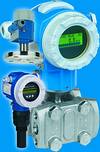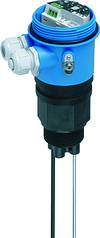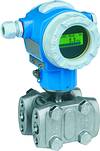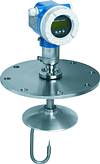

Endress+Hauser offers what is believed to be the widest range of level instruments and technology available from any single source in South Africa. Access to such a broad range of measuring principles available means that finding a suitable solution is made far easier.
Since no single measuring principle is suited to all areas of application, Endress+Hauser is placed in a good position to offer a measuring system that will work reliably under the conditions specific to the customers needs - while bearing in mind the economic considerations of the future.
As a market leader in level measurement, Endress+Hauser supports customers from planning and commissioning, through to maintenance. Clients are also assisted in automation, asset management and visualisation of process data.
Segmented offering
The company's S-M-T model structure means that each instrument is available in three different segments. This classification allows customers to select suitable solutions so that they do not find themselves having to pay for something that they do not need.
The T segment stands for 'top quality instruments' for simple applications. The M segment represents 'multitalented solutions' for diverse applications, while the S segment stands for 'special technology' which meets the highest demands. The instruments in the S and M segments have a modular design and offer a variety of process connections, sensor materials, housings, electronic interfaces, certificates and approvals, as well as special designs.
Level measurement is divided into four areas: liquids - including liquefied gases, bulk solids, continuous measurement and level limit detection. Endress+Hauser provides measuring principles for each area.
In level limit detection, the essential tasks are to avoid overfilling or excessive emptying of the tanks and protect pumps from running dry. Fast, safe functioning and high reproducibility are key. Continuous measurement determines the level of media - it effectively measures length, which can range from a few centimetres for control tasks, to several metres in bulk solid applications. The product volume may also be indirectly determined by taking heed of the geometric form and dimensions of the tank, as well as the physical properties of the medium.

Radar
The time of flight measuring principle allows for level measurement in a variety of applications. Different requirements in continuous level measurement require special measuring principles. Endress+Hauser's radar technology for example, has established itself in large areas of the chemical industry. New developments now extend the range to bulk solids applications.
Endress+Hauser recently installed Micropilot M FMR250 to a Ferrochrome mine in Middelburg - making it South Africa's first successful solids radar application. This achievement was largely attributed to the development of auxiliary components, which achieved a significant increase in radar sensor sensitivity with low power input. Endress+Hauser recently replaced a higher maintenance - lower accuracy, electro mechanical plumb line at a 50 m cement silo, at a leading local cement company, using a parabolic antenna Micropilot M FMR250. In so doing, cost savings and improved efficiency have been realised.

Guided radar
Guided level radar measurement in the form of Endress+Hauser's Levelflex M, has established a place in many silo applications. Over the years, this technology has evolved into solutions for liquid (petrochemical) applications. Levelflex M is virtually independent of the medium surface and is thus suited to foam, angled surfaces and turbulence. With over 50 000 guided level instruments installed worldwide, Endress+Hauser is believed to offer the most extensive application experience in the market.
Ultrasonic
Ultrasonics constitutes standard, cost-effective solutions in bulk solids measurement and in the area of water and wastewater treatment. The Prosonic S/M/T is cost-effective, non-contact ultrasonic measurement for tanks, basins and agitated vessels, on stockpiles and conveyor belts. This ultrasonic range represents over 35 years of successful growth and development.

Capacitance
Capacitance is the founding principle of level measurement, and is based on the capacity change of a capacitor due to the changing proximity of the medium when there are changes in level. Although this represents a somewhat dated principle, the technology has been enhanced to suit particular applications. Liquicap T for example has grown to become significantly more independent of dielectric constants. The probe is pre-calibrated to the ordered length at the factory, making customer calibration unnecessary. As many small storage and buffer tanks across industries have not yet been equipped with instrumentation, the unique price/performance ratio and distribution via Endress+Hauser's online shopping service E-direct, make Liquicap T an optimum solution for such applications.
Hydrostatic pressure
Hydrostatic pressure sensors for level measurement may be used in virtually all liquid media, from water through to pastes and sludges. Even under the most difficult process conditions, these sensors may be adjusted to the application in an optimum fashion. Waterpilot is predominately used for level measurement in deep tanks, boasting robust housing with a small probe diameter, as well as high accuracy. Deltapilot S offers a hygienic instrument design that is suitable for the food and pharmaceutical industries. Deltabar S, with its robust sensor technology and high overload resistance, is good for applications in pressurised tanks in, for example, the chemical and petrochemical industries.

Limit detection
Level limit detection has become an indispensable variable in process engineering. However, the application and medium limitations of purely mechanical and purely electronic systems prompted Endress+Hauser to combine both systems into one measuring principle - vibronics - vibrating limit switches for liquids and bulk solids. State-of-the-art development tools such as the Finite Element Method, new production technologies and constant improvements have culminated in a mechatronic success story for these limit switches.
Over a short period the Liquiphant and Soliphant ranges have became viewed as classics. Today, more than 3 million measuring points have been installed worldwide. The Soliphant FTM50 series now offers longer and shorter fork lengths for greater flexibility in application. A build-up, display and density setting and a switching delay are two new optional features. Although there are a number of single rod sensors in the market, last year, Soliphant T from Endress+Hauser became the first to offer a new tilted piezo drive located inside the tip of the sensor rod, safeguarding the instrument's unique performance. Soliphant T is mechanically balanced, resulting in higher resistance vibration and build-up. The end result is a significant reduction in the number of false trips.
Radiometric methods
For over a decade, radiometric measurement has been providing decisive advantages in level limit detection, level, density, and interface measurement. Radiometric instrumentation is used where other measuring principles fail, due to extreme process conditions or because of mechanical, geometric or construction conditions. The Gammapilot M FMG 60 operates via the ToF tool operating software - Fieldtool. All measuring tasks are thus configured and operated with the same software. The latest generation Gammapilot M is also easy to set up and simple to calibrate.
Conductive sensing
The conductive measuring principle is the answer to simple, safe detection of a limit value in conductive liquids. Liquipoint T is able to perform in applications from secure inventories (minimum quantity) and the avoidance of tank overflow, through to two-point and multipoint control (pump control). The introduction of Liquipoint T FTW 31 and FTW 32 offered a conductive level limit switch with the ability to detect up to five level limits in all conductive liquids. This is believed to have been a first.
Sounding
Old seafarers used a weight on a rope to test the depth to the bottom of the sea. In industrial level measurement, this basic idea of 'sounding' is still utilised, in the way of the electromechanical level system. Where other measurement methods are limited, applications involving bulk solids predominantly use electromechanical level measurements. The Silopilot M FMM760 recently evolved to the new Silopilot M FMM 50, offering both single and 3-phase connection. Its menu guided standard set-up spans across almost every other product.
Continuous optimisation of Endress+Hauser's processes and the use of innovative technology have enabled the company to extend the frontiers of measurement, control and automation engineering and to find safe and efficient solutions. Milestones claimed in level measurement include the first radiometric measuring line in 1962, the first vibration limit switch for liquids in 1983 and Micropilot, the first level radar for non-contact measurement. More recently, Endress+Hauser became the first to implement Fieldbus technology to the industry. The company looks set to continue to strengthen its presence throughout all areas of process automation.
For more information contact Sean Frost, Endress+Hauser, 011 262 8000, [email protected], www.endress.com
| Tel: | +27 11 262 8000 |
| Email: | [email protected] |
| www: | www.endress.com |
| Articles: | More information and articles about Endress+Hauser South Africa |

© Technews Publishing (Pty) Ltd | All Rights Reserved